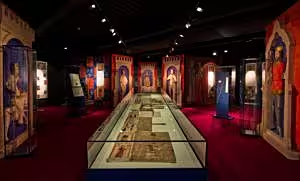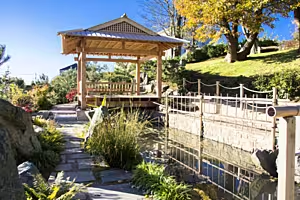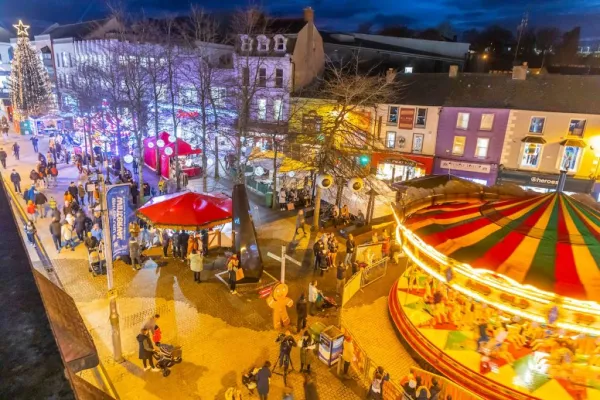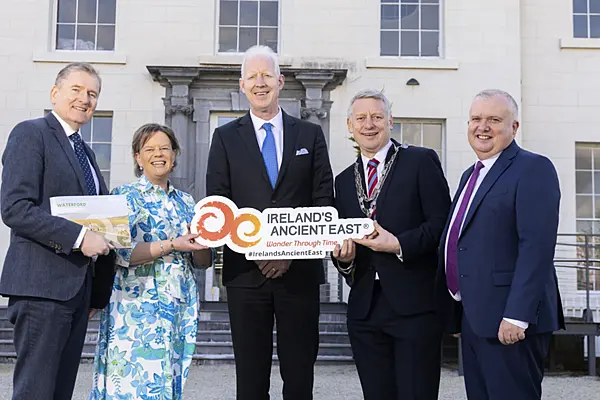As Ireland’s oldest city, it is no surprise that Waterford offers an abundance of culture, history, and natural beauty. Waterford was founded by the Vikings in 914 AD and has plenty of castles, towers, and ancient dwellings to visit.
For food lovers, the Waterford Harvest Festival offers a great opportunity to sample Ireland’s finest culinary culture, where visitors can savour local delicacies and artisanal products.
With all these factors in mind, Hospitality Ireland decided to examine the top ten visitor attractions in Waterford, based on Fáilte Ireland’s Visitor Attractions Survey 2022.
1. The House Of Waterford Crystal
(75,000)
The House of Waterford Crystal is number one on the list, with 75,000 visitors as of 2022.
Visitors can see how master craftsmen transform blocks of crystal into elegant shapes and figures with their sculpting wheels.
The House of Waterford Crystal offers the largest collection of Waterford in the world.
The 12,000-square-foot retail store gives visitors the opportunity to choose a piece of crystal to take home.
The retail store represents the entire catalogue of luxury crystal, including an exhibition of golf and world sports trophies.

2. Medieval Museum (Waterford Treasures Museum)
(55,280)
The Medieval Museum is located in the Viking Triangle, Waterford City’s cultural and historic quarter, and this opening completes the museum trilogy that includes Reginald’s Tower and the Bishop’s Palace, and it is the last in the complex of museums that trace the history and archaeology of Waterford from its foundations by Viking pirates in 914 AD up to the present day.
The Medieval Museum is unique in that it is the first purpose-built medieval museum in Ireland, and the first modern building to incorporate a medieval building.
The great sweep of Dundry stone that creates the dramatic facade was sourced at the stone quarry near Bristol – the same quarry that 800 years ago was used to build the thirteenth-century Chorister’s Hall that sits beneath the museum.

3. Lafcadio Hearn Japanese Gardens
(36,000)
The idea for the Lafcadio Hearn Japanese Gardens first arose in 2012, when Professor Bon Koizumi – the great-grandson of Lafcadio Hearn – with his wife, Shoko, visited Tramore to retrace the steps of his famous ancestor, who had spent his childhood summers in the seaside town.
The journey begins in a Victorian garden that commemorates Hearn’s childhood summers in Tramore. Later, there are American and Greek gardens, followed by a series of Japanese-inspired landscapes.
After passing beneath a fujidana (wisteria trellis), visitors reach a traditional Japanese tea house and tea garden, followed by a stream garden, which leads to ponds, a waterfall, and an extensive woodland area.
The main elements of design – in particular, the use of rocks and water and the plant selection – are influenced by the tradition of a Japanese strolling garden.
The 2.5-acre gardens are set on a hillside overlooking Tramore Bay.

4. Lismore Castle Gardens
(32,310)
Lismore Castle Gardens collectively cover ten acres and are the oldest cultivated gardens in Ireland.
The gardens are set within the outer defensive walls and are divided into three distinct parts: the Reilig Garden, the Upper Garden, and the Lower Garden.
Some of the walls around this garden date back to the thirteenth century. The Reilig Garden leads to the Upper Garden, which was first constructed by Richard Boyle, the first Earl of Cork, in about 1605.
Most of the walls and terraces remain the same, although the plantings have changed to suit the tastes of those living within the castle. This garden is a mix of ornamental borders and productive areas, with vegetables, herbs, fruit and flowers grown for the kitchen and house.

5. Reginald’s Tower
(27,910)
Reginald’s Tower has never fallen into ruin and has been in continuous use for over 800 years.
It was originally the site of a wooden Viking fort, and the stone tower that we see today actually owes its existence to the Anglo-Normans, who made it the strongest point of the medieval defensive walls.
Later, it was utilised as a mint under King John, before serving various functions under many English monarchs.
On two floors is housed one branch of the Waterford Museum of Treasures, concentrating on the town’s Viking heritage.

6. Waterford Suir Valley Railway
(26,546)
The Waterford Suir Valley Railway Company CLG was established to preserve and promote Waterford’s railway heritage.
The railway follows the ten kilometres of the abandoned Waterford-Dungarvan railway line, from the station at Kilmeadan/Kilmeaden, Co. Waterford, to Bilberry, in Waterford City, running beside the Waterford Greenway.
Travelling at 15 kilometres per hour, travellers can view Suir Valley from a partially opened carriage, as they take in the views of the river and rolling farmland of Waterford and across the river, to Co. Kilkenny.
The track runs mostly along the picturesque banks of the River Suir and beside the Waterford Greenway. Travellers can also get a glimpse of Mount Congreve Gardens.

7. Lismore Heritage Centre
(24,210)
The Lismore Heritage Centre allows visitors to get a full tour of the town.
The 360-degree experience is the only way to catch a glimpse inside this castle. Visitors can hear the story of the Book of Lismore and the Bishop’s Crozier, which were hidden in the walls of the castle for almost two centuries.
Lismore Castle was built by King John in 1185, to guard the river, and was lived in by Sir Walter Raleigh.

8. Bishop’s Palace (Waterford Treasures Museum)
(18,597)
The Bishop’s Palace, in Cathedral Square, was conserved in 2010/11 and opened as a museum in June 2011, displaying the treasures of Georgian and Victorian Waterford.
The ground and first floors are furnished as an eighteenth-century townhouse would be, with some of the finest displays of eighteenth-century glass, silver, furniture and paintings in Ireland.
The oldest piece of Waterford glass in the world – the Penrose Decanter – is a highlight.

9. Irish Museum Of Time (Waterford Treasures Museum)
(14,326)
The Irish Museum of Time, in Greyfriar’s Church, is Ireland’s only horological museum, featuring some of the oldest Irish longcase clocks, table clocks, and watches in the world.
The museum tells the story of 5,000 years of timekeeping history and features some of the oldest Irish-made grandfather clocks, table clocks, and watches.
The collection on display is not only limited to Ireland, as there are also some early European timepieces, with some dating back to the mid-sixteenth century.

10. Dungarvan Castle
(9,768)
Dungarvan Castle is an Anglo-Norman fortification founded in 1185.
It consists of a polygonal shell keep with an enclosing curtain wall, a corner tower, and a gate tower. The shell keep is the earliest structure, dating from the twelfth century.
Inside the curtain wall is a two-storey military barracks, which dates from the first half of the eighteenth century. The barracks is now restored and houses an informative exhibition on the history of the castle.









